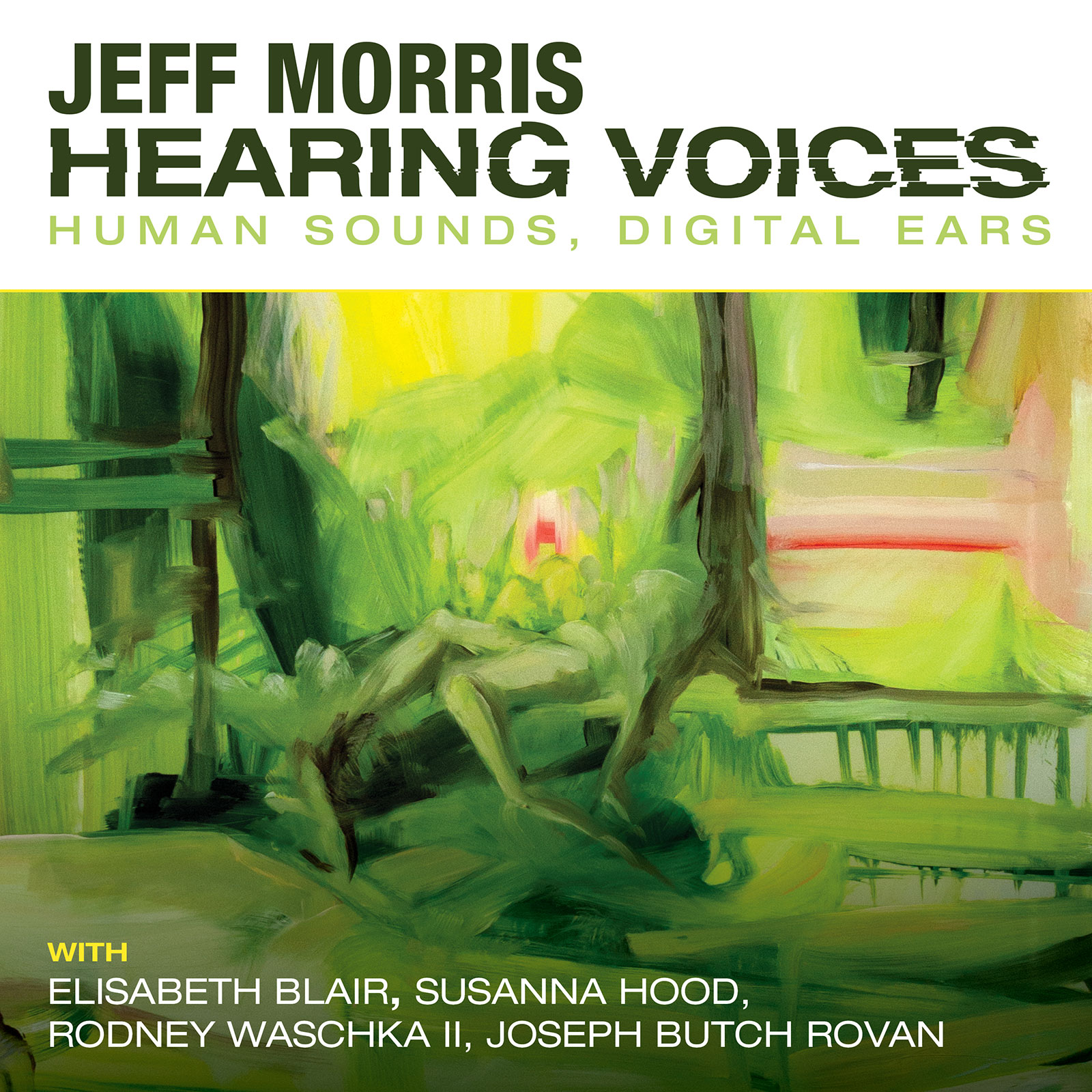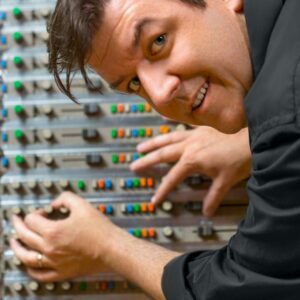
Share Album:
Hearing Voices
Jeff Morris composer
Elisabeth Blair vocals
Susanna Hood vocals
Rodney Waschka II vocals
Joseph Butch Rovan vocals
In HEARING VOICES, his third album of electronic music with Ravello Records, Jeff Morris captivates the psyche with music that is equal parts space age and primeval. With Morris’s characteristic sensitivity, the collection harnesses the expressive power of digital glitches, sonic manipulation, and underneath it all, the human voice.
In the Middle of the Room opens the album with what sounds like an other-worldly chorus of singers. In reality, the vocalizations are those of a single person, Elisabeth Blair, whose voice refracts at different pitches; Blair’s song is electronically contorted by Morris in real time using a technique he calls “live sampling.” The improvised lyrics, on the verge of unintelligibility, seem vaguely reminiscent, as if they have drifted from a long forgotten songbook of old standards. Next, in Definition of A, singer Susanna Hood lends her voice to form a turbulent cloud of “proto-words,” which tantalize the brain, promising meaning without definition. Again, Morris wrestles with these vocal improvisations in real time, almost maniacally tugging and jerking at the electronic marionette strings.
Later, we hear Jabberwocky—A Timbre Poem, which sets Lewis Carroll’s famous stanzas of nonsense words. Eerie and entrancing, the piece denies sense in exchange for sensation; voices whisper and rumble their strange incantations as digitized rhythms pound behind them. The album closes with Reprise (Hearing Voices). Here, through the prism of a machine learning algorithm, Morris revisits themes from earlier in the album, punctuated by static and expansive silence.
In HEARING VOICES, Jeff Morris reminds us that often it is only by obscuring that which is familiar that we begin to recognize and understand it. There is little in life that is at once as pedestrian and, yet, as profoundly elemental, as the voice. Beyond the cacophony of digital synapses firing, beyond logic and language, Morris’s music strives to uncover our most fundamental humanity.
Listen
Stream/Buy
Choose your platform
Track Listing & Credits
| # | Title | Composer | Performer | |
|---|---|---|---|---|
| 01 | In the Middle of the Room | Jeff Morris | Elisabeth Blair, voice; Jeff Morris, electronics | 9:55 |
| 02 | Definition of A | Jeff Morris | Elisabeth Blair, voice; Susanna Hood, voice; Jeff Morris, electronics | 10:17 |
| 03 | A Tuesday with Rodney: No. 1, Classical Form | Jeff Morris | Rodney Waschka II, voice; Jeff Morris, electronics | 8:13 |
| 04 | A Tuesday with Rodney: No. 2, Ballad | Jeff Morris | Rodney Waschka II, voice; Jeff Morris, electronics | 6:14 |
| 05 | A Tuesday with Rodney: No. 3, Schenkerian Blues | Jeff Morris | Rodney Waschka II, voice; Jeff Morris, electronics | 5:53 |
| 06 | Jabberwocky (A Timbre Poem) | Jeff Morris | Jeff Morris, voice; Joseph Butch Rovan, voice | 5:11 |
| 07 | Reprise (Hearing Voices) | Jeff Morris | Jeff Morris, electronics | 4:33 |
TRACKS 1, 2
Recorded May 20, 28, 2015, at the Atlantic Center for the Arts in New Smyrna Beach FL
TRACKS 3–5
Recorded October 7, 2014, at North Carolina State University in Raleigh NC
TRACK 6
Recorded November 8, 1999, at Florida State University in Tallahassee FL
TRACK 7
Recorded November 30, 2019, at Texas A&M University in College Station TX
Cover art (left image): In the Middle of the Room, 2019, oil on polyester film, by April Zanne Johnson www.aprilzannejohnson.com
Executive Producer Bob Lord
Executive A&R Sam Renshaw
A&R Director Brandon MacNeil
VP, Audio Production Jeff LeRoy
Audio Director Lucas Paquette
Mastering Shaun Michaud
VP, Design & Marketing Brett Picknell
Art Director Ryan Harrison
Design Edward A. Fleming
Publicity Patrick Niland, Sara Warner
Artist Information

Jeff Morris
Jeff Morris creates musical experiences that engage audiences’ minds with their surroundings. His performances, installations, lectures, and writings appear in international venues known for cutting-edge arts and deep questions in the arts. He has won awards for making art emerge from unusual situations: music tailored to architecture and cityscapes, performance art for the radio, and serious concert music for toy piano, robot, Sudoku puzzles, paranormal electronic voice phenomena, and live coding using algebra and breath-controlled piano.
Elisabeth Blair
Elisabeth Blair is a poet, composer, podcaster, and multidisciplinary artist. She has been artist-in-residence at the Atlantic Center for the Arts, the Kimmel Harding Nelson Center for the Arts, and ACRE. From 2016–2019 she hosted and produced the podcast Listening to Ladies, and she currently leads the poetry workshops for the Burlington Writers Workshop. elisabethblair.net
Susanna Hood
Based in Montreal, Susanna Hood is a compelling and virtuosic performer in dance and music and was the artistic director of her interdisciplinary performance company hum dansoundart from 2000 to 2013. She began her career as a member of the Toronto Dance Theatre from 1991 through 1995. She has performed the works of various Canadian choreographers, composers, and filmmakers (including Tedd Robinson, John Oswald, Nilan Perera, and Phillip Barker). She synthesizes voice and movement into a dynamic practice that creates intimate, raw, and sensual performances. susannahood.ca
Rodney Waschka Ii
Rodney Waschka Ii is best known for his algorithmic compositions, unusual operas, and theater pieces. An expert in computer music, his works often include electronic computer music or other media: visuals, theater, or poetry. His music has been performed throughout North America and Europe, as well as Asia, South America, Israel, and South Africa, at festivals including the Sound Ways Festival in Russia, and numerous instances of the International Computer Music Conference and the Society for Electro-Acoustic Music in the US (SEAMUS) festival. www.waschka.info
Joseph Butch Rovan
Joseph Butch Rovan is a composer, media artist, and performer at Brown University, where he co-directs MEME (Multimedia & Electronic Music Experiments @ Brown). He has also directed the Center for Experimental Music and Intermedia at the University of North Texas and was a compositeur en recherche with the Real-Time Systems Team at the Institut de Recherche et Coordination Acoustique/Musique (IRCAM) in Paris. Rovan worked at Opcode Systems before leaving for Paris, serving as Product Manager for MAX—the main platform used to make this album. www.soundidea.org
Notes
Remember what a “bad” analog connection was like? It’s hard to find these days, unless your car is old or un-fancy enough. A poor signal meant that we could still hear the person on the other end, just minus a little detail, and plus a little static noise. Still, we could listen through the static and the dull tone and connect with the person on the other end. It’s different with a digital signal. It’s great that with a good connection, you can reproduce the original sound with all the fine detail and without the static, but with a bad connection, it gets interesting: if the sound doesn’t drop out altogether, it’s replaced with blocky metallic digital burps that are hard to ignore. Still, we try even harder to ignore those glitches (like we ignore the candy wrapper crackling in the audience—it’s not what we came for), and we tend not to notice how our digital things are shaping the ways we go about being human. For example, did you notice how video chatting has broken eye contact? How emoji partially “humanize” words but also boil human expression down to an alphabet of cartoons? It’s weird, and we should recognize it, how it bends us out of shape, and how we can be human despite it.
This album can’t do all of that for you, but we hope it starts you thinking about your digital world, as we explore the musical potential of embracing digital glitches and the marks they leave on the most human of sounds, the voice, take the glitches into our own hands, and make them speak for us.
Most of the music here was made with a technique called live sampling. Rather than recording sounds and editing them into musical compositions after the fact, I perform, with digital instruments I built that can only record and transform the sounds happening live in the moment. I give my instruments the ability to make some creative decisions on their own, and they each give me different ways to influence the performance as it goes without totally controlling it. This stimulating and precarious creative predicament intensifies our imaginations, reaches deep into our intuitions, and lets music emerge that we never would have conceived in a calm, controlled setting. It gives a voice to ideas and relationships we didn’t know were there.
In the Middle of the Room was a live sampling improvisation with Elisabeth Blair. The lyrical content was inspired by Elisabeth’s friendship with an extraordinary woman who, sadly, passed away soon after this performance. A text version of this work was printed in the Cream City Review, and a video version is included in their online exhibit for hybrid literature, IØ. We’re proud this work was selected for the International Society for Contemporary Music’s prestigious World Music Days, one of only six pieces representing the United States, among 74 works from composers worldwide.
Next, Susanna Hood joins us in a trio that explores a different sound world, where the words only seem to raise more questions. Previously, I had only done live sampling improvisations with instrumentalists. Words obviously carry another level of meaning, but partial words, proto-words, sounds that make you think you might be hearing words, and even non-verbal gestures all open up worlds of potential meanings, each unique to the listeners’ own imaginations, experiences, and attention. Here, we don’t have a particular story to tell. Instead, we’re climbing into our own sounds and exploring wherever their story-ness and musicality lead us.
Each track and each vocalist takes a different approach to responding to and exploring this sonic hall of mirrors he or she has entered. The improvisations with Rodney Waschka II, who is also a computer music composer, embrace the humorous artifacts of sampling most directly, and by treating them seriously, greeting the absurdity with its own logic, we end up finding ourselves in even more new creative spaces we didn’t know existed.
Jabberwocky—A Timbre Poem was actually my first computer music composition. It’s a setting of Lewis Carroll’s “Jabberwocky,” and like 19th-century “tone poems” told stories through melodies, this “timbre poem” illustrates Carroll’s story through the sounds spoken by me and my mentor, Joseph Butch Rovan. Everything in this composition comes from the sounds of words.
The final track revisits themes from the album, through the perspective of a machine learning algorithm. It also uses electronic voice phenomena (EVP), through a special recipe developed with Miguel Espinel. Here, the static isn’t added after the fact, but rather, any voices you hear emerge from it.
The cover art comes from visual artist April Zanne Johnson, who created it from her perceptual responses to the album. (aprilzannejohnson.com)
Thanks to Rodney Waschka II and North Carolina State University for having me over to make and share music; the Atlantic Center for the Arts and also Karl Berger and Ingrid Sertso for bringing me, Elisabeth, Susanna, and April together in an artist residency and for fostering a culture of collaborative explorations there; Butch Rovan for building the computer music program at Florida State University where I began making music in this way; and the Texas A&M University President’s Excellence Fund, Academy for Visual and Performing Arts, College of Liberal Arts, and Department of Performance Studies for making this work possible.
— Jeff Morris
Videos
In the Middle of the Room
Laurel is Yanny is Facebook is
